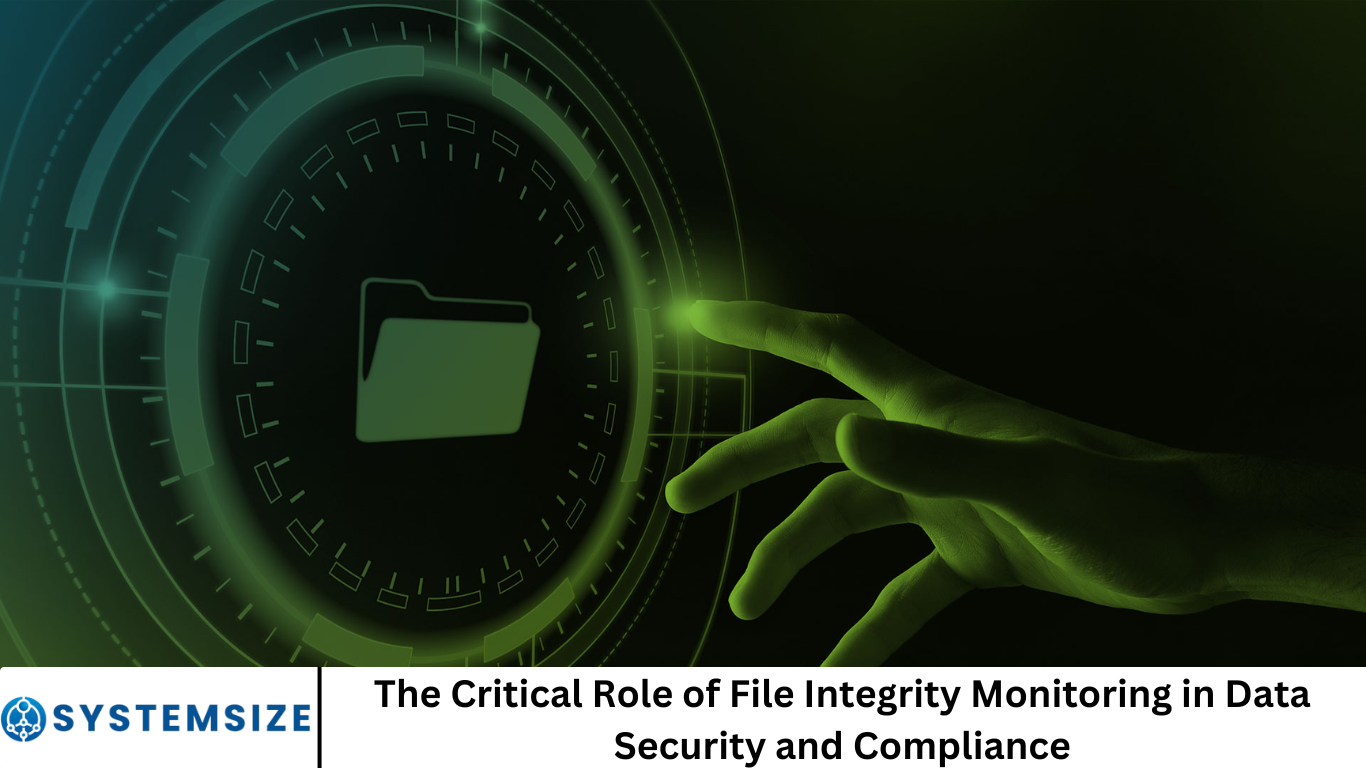Digital-first world, businesses generate and process massive volumes of data—sensitive customer records, financial transactions, intellectual property, and more. Protecting this data is not only a business imperative but also a legal requirement. Data breaches, regulatory fines, and reputation damage are constant risks.
Within this context, File Integrity Monitoring (FIM) stands out as a vital safeguard—a powerful technology that detects unauthorized changes to critical files and ensures compliance with data protection laws.
Explores why FIM is essential for modern organizations. We’ll cover its definition, benefits, deployment methods, role in compliance, best practices, and real-world applications. By the end, you’ll understand why FIM isn’t optional—it’s a foundational element in any robust data security and compliance strategy.
More Read: Top 7 Data Analysis Tools to Streamline Your Workflow in 2024
1. What Is File Integrity Monitoring (FIM)?
File Integrity Monitoring is a security solution designed to:
- Continuously monitor and record key attributes of critical system files, configuration files, executables, and directories.
- Detect unauthorized or unexpected changes that could signal cyberattacks, insider threats, or configuration errors.
- Alert administrators to anomalies or integrity violations for prompt investigation and remediation.
A typical FIM system captures metadata such as hash values, file size, permissions, ownership, and timestamps, comparing each snapshot against a known “good” baseline. Any deviations trigger real-time alerts—allowing organizations to respond immediately and mitigate threats before they escalate.
2. Why Data Integrity Matters
Regulatory Drivers
A growing number of privacy and data protection regulations mandate data integrity and logging controls. File integrity monitoring helps organizations comply with requirements under:
- GDPR – Enforces data accuracy, confidentiality, and integrity of EU citizens’ data.
- CCPA – Empowers California consumers with rights over their personal information.
- PIPL – Governs the storage and processing of Chinese personal information.
- PCI DSS – Requires merchant systems to track file access and detect unauthorized changes.
- HIPAA, SOX, GLBA, FISMA, and more enforce similar standards.
Failing to prevent or detect unauthorized changes can result in hefty fines, legal liability, and public trust erosion.
Operational Resilience
Beyond compliance, maintaining file integrity supports:
- Auditable evidence trails – Useful during security audits, forensic investigations, or data audits.
- Configuration drift detection – Highlights when critical settings deviate from secure standards.
- Insider threat protection – Detects employees or contractors making unauthorized file modifications.
- Malware countermeasures – Flags suspicious behavior like ransomware encrypting system files.
3. How File Integrity Monitoring Works
FIM solutions typically follow this cycle:
- Inventory and Baseline
- Identify files, directories, and configuration locations to monitor.
- Capture baseline attributes, including cryptographic hash values.
- Change Detection
- Periodically or continuously compare current file attributes to the baseline.
- Detect unauthorized edits, additions, deletions, or renames.
- Alerting & Logging
- Generate real-time alerts with context (user, process, timestamp).
- Log every change in a centralized, tamper-evident system for audit purposes.
- Analysis & Response
- Investigate alerts for legitimacy, root cause, and business impact.
- Respond by reversing changes, patching vulnerabilities, terminating malicious processes, or escalating to incident response teams.
4. Deployment Models & Integration
On-Premises Agents
Installed directly on endpoints—servers, workstations, network appliances—to monitor file systems in real time.
Pros:
- Fast detection
- Minimal network latency
- Full control over data
Cons:
- Requires maintenance and updates
- Higher deployment overhead
Agentless or Network-Based
Monitors networked file systems (SMB, NFS) or cloud storage without installing software locally.
Pros:
- Easier rollout
- No agent management
Cons:
- Broader visibility, but slower detection
- Possible network performance impact
Cloud-Native & Container Environments
Cloud approaches integrate FIM with cloud APIs and Kubernetes architecture.
Pros:
- Native cloud visibility
- Easy scaling
- Fits DevOps and infrastructure as code pipelines
Cons:
- Complexity for hybrid environments
Integration with SIEM & SOAR
FIM streams logs and alerts into Security Information and Event Management (SIEM) or Security Orchestration and Response (SOAR) platforms to:
- Enrich detection with contextual threat intelligence
- Automate triage and remediation
- Generate compliance reports (e.g., PCI DSS Rule 11.5)
5. File Integrity Monitoring Best Practices
- Identify High-Risk Resources
- Focus on system files, databases, configuration files, sensitive documents, SSL certificates.
- Tune for Relevance
- Avoid alert fatigue by whitelisting expected changes—patches, updates, configurations.
- Secure the FIM Infrastructure
- Isolate FIM servers, encrypt communications, and deploy tamper-resistant logs.
- Automate Incident Response
- Integrate FIM alerts with SIEM/SOAR, automate workflows, and trigger scripts or contain threats.
- Maintain Audit Trails
- Retain logs as governed by compliance standards, ensuring immutability.
- Routine Testing & Calibration
- Validate that FIM detects simulated alterations. Adjust hashing frequency and file scope.
- Combine with Detection Capabilities
- Integrate with EDR, vulnerability scanners, and antivirus for defense-in-depth.
6. FIM’s Role in Compliance Frameworks
GDPR
Article 5 mandates data integrity and confidentiality. FIM helps ensure only authorized, transparent changes are made to personal data. Audit logs support Article 30 record-keeping, while breach detection aligns with Article 33 obligations.
CCPA
By tracking access and modifications to personal consumer data, FIM assists with rights requests and breach response—helping avoid penalties of up to $7,500 per intentional violation.
PIPL
Mirrors GDPR’s requirements. FIM provides records of personal data changes and supports consent-tracking mechanisms.
PCI DSS
PCI Requirement 11.5 mandates file change detection to monitor unauthorized access or alteration to files, especially audit trails and configuration files. FIM fulfills this obligation with logs and alerting.
HIPAA / SOX / GLBA
Various regulations demand data integrity and auditability. FIM logs access to healthcare and financial data, helping organizations meet compliance and avoid fines.
7. Real-World Use Cases
Detecting Ransomware
Ransomware attacks often modify or encrypt files en masse. FIM flags unexpected encryption changes, enabling incident response to shut down affected hosts and restore files from backup.
Insider Threats
A disgruntled employee tampers with HR databases or financial records. FIM alerts administrators to unauthorized alterations, enabling intervention before damage spreads.
Configuration Drift in Distributed Systems
Configuration files diverge from secure standards over time. FIM detects such drift, triggering remediation before they lead to vulnerabilities like open ports or insecure settings.
Audit Trail Tampering
Malicious actors may erase system logs to conceal criminal behavior. FIM monitors OS logging directories to preserve evidence and detect tampering.
8. Comparing FIM Solutions
When choosing a FIM solution, consider:
- Agent-based vs. agentless
- Real-time vs. scheduled scanning
- Integration with SIEM, EDR, cloud platforms
- Supported platforms (Windows, Linux, macOS, container systems)
- Ease of management and reporting
- Scalability (on-prem built for large enterprises vs. cloud-hosted offered as SaaS)
Popular tools include:
- OSSEC
- Tripwire IP360
- Tripwire Enterprise
- Qualys File Integrity Monitoring
- McAfee Change Control
- CrowdStrike Falcon File Integrity
- Tenable.io / Tenable.sc
Each supports snapshotting, alerting, and auditing—with varying degrees of automation and threat intelligence feeds.
9. ROI and Business Value
Implementing a robust FIM system may require investment—agents, administration, SIEM integration. But the returns are significant:
- Avoid costly breaches – the average data breach costs millions.
- Protect regulatory status – avoiding fines and legal consequences.
- Reduce downtime – early detection minimizes impact.
- Provide audit-readiness – smooth passage through audits.
- Prevent compliance violations – especially for regulated industries.
When hidden costs like breach resolution, legal defense, and brand repair are factored in, FIM becomes a clear and compelling investment.
10. Future Outlook & Trends
- Cloud-native & serverless FIM – tracking changes in container images, cloud storage, and function-as-a-service systems.
- AI-powered anomaly detection – using machine learning to spot irregular patterns and reduce false positives.
- Zero Trust Alignment – coupling FIM with identity and access policies in highly secure, least-privilege environments.
- Blockchain-based verification – ensuring integrity baselines can’t be tampered with.
- Increased regulation – more global frameworks—similar to GDPR—will make FIM even more critical.
Frequently Asked Question
What is File Integrity Monitoring (FIM), and how does it work?
File Integrity Monitoring (FIM) is a security process that detects unauthorized changes to files, configurations, and system settings. It works by creating a baseline of file attributes (like hash values, permissions, size, and timestamps), then continuously comparing this baseline to current file states. If unauthorized changes occur, FIM generates alerts for investigation and response.
Why is File Integrity Monitoring important for data security?
FIM helps protect sensitive data by:
- Detecting malware, ransomware, and insider threats
- Preventing unauthorized access or tampering with system files
- Ensuring system configurations remain secure
- Providing early warnings of suspicious activity
This makes it a key defense layer in preventing breaches and maintaining overall data security.
How does FIM support regulatory compliance?
Many data protection regulations require organizations to maintain data integrity and track access to sensitive files. FIM supports compliance by:
- Creating audit trails for file changes
- Helping meet mandates in GDPR, PCI DSS, HIPAA, CCPA, and PIPL
- Providing evidence of due diligence and breach detection mechanisms
Failure to implement FIM can result in fines, penalties, and compliance violations.
What types of files should be monitored using FIM?
FIM should monitor:
- System files (e.g., OS kernels, registry entries)
- Configuration files (e.g., firewall rules, database settings)
- Application binaries and executables
- Sensitive data files (e.g., customer records, financial documents)
- Log and audit files
Prioritizing critical or high-risk files ensures maximum security impact.
Can FIM be used in cloud or hybrid environments?
Yes. Modern FIM solutions support cloud-native, hybrid, and containerized environments. They integrate with cloud platforms (like AWS, Azure, GCP) and tools such as Kubernetes to monitor cloud storage, virtual machines, and containers. Some solutions are agentless, while others use lightweight cloud agents.
How is File Integrity Monitoring different from antivirus or SIEM tools?
- Antivirus detects and removes known malware but doesn’t monitor file changes.
- SIEM aggregates and analyzes logs for threat detection.
- FIM specifically watches for unauthorized changes to critical files—including those made by malicious insiders, malware, or accidental errors.
FIM complements antivirus and SIEM to provide a more complete security posture.
What are best practices for implementing File Integrity Monitoring?
- Identify and prioritize critical files and systems
- Set a secure baseline and review it regularly
- Tune alerts to avoid false positives
- Integrate FIM with SIEM or SOAR tools
- Automate responses where possible
- Conduct regular audits and compliance checks
- Train staff on interpreting FIM alerts and reports
Conclusion
Monitoring (FIM) plays a crucial role in safeguarding your organization’s data and systems. By continuously tracking and analyzing changes to critical files, FIM not only strengthens your overall data security posture but also helps meet compliance mandates like GDPR, CCPA, PIPL, PCI DSS, and more. FIM acts as both a preventive and detective control—helping identify malicious activity, accidental misconfigurations, and insider threats before they lead to data breaches or operational disruptions. When integrated with broader security tools like SIEM or SOAR, it becomes a powerful part of a defense-in-depth strategy.


